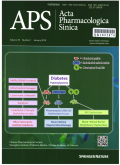- 钛学术文献服务平台 \
- 学术期刊 \
- 医药卫生期刊 \
- 药学期刊 \
- 中国药理学报(英文版)期刊 \
Hypoxia, HIF-1α, and COVID-19: from pathogenic factors to potential therapeutic targets
Hypoxia, HIF-1α, and COVID-19: from pathogenic factors to potential therapeutic targets
基本信息来源于合作网站,原文需代理用户跳转至来源网站获取
摘要:
The pandemic of coronavirus disease 2019 (COVID-19) and its pathogen,severe acute respiratory syndrome coronavirus 2 (SARS-CoV-2) have become the greatest current threat to global public health.The highly infectious SARS-CoV-2 virus primarily attacks pulmonary tissues and impairs gas exchange leading to acute respiratory distress syndrome (ARDS) and systemic hypoxia.The current pharmacotherapies for COVID-19 largely rely on supportive and anti-thrombi treatment and the repurposing of antimalarial and antiviral drugs such as hydroxychloroquine and remdesivir.For a better mechanistic understanding of COVID-19,our present review focuses on its primary pathophysiologic features: hypoxia and cytokine storm,which are a prelude to multiple organ failure and lethality.We discussed a possible link between the activation of hypoxia inducible factor 1α (HIF-1α) and cell entry of SARS-CoV-2,since HIF-1α is shown to suppress the angiotensin-converting enzyme 2 (ACE2) receptor and transmembrane protease serine 2 (TMPRSS2) and upregulate disintegrin and metalloproteinase domain-containing protein 17 (ADAM17).In addition,the protein targets of HIF-1cα are involved with the activation of pro-inflammatory cytokine expression and the subsequent inflammatory process.Furthermore,we hypothesized a potential utility of so-called "hypoxic conditioning" to activate HIF-1α-induced cytoprotective signaling for reduction of illness severity and improvement of vital organ function in patients with COVID-19.Taken together,we would propose further investigations into the hypoxia-related molecular mechanisms,from which novel targeted therapies can be developed for the improved management of COVID-19.

推荐文章
COVID-19临床资料分析
新型冠状病毒
感染
新型冠状病毒性肺炎
COVID-19肺炎影像学诊断价值
COVID-19
计算机断层
X线
影像学表现
HIF-1反义核酸对金鱼HIF-1α及其靶基因VEGF表达水平的影响
HIF-1
反义核酸
低氧
金鱼
内容分析
关键词云
关键词热度
相关文献总数
(/次)
(/年)
文献信息
| 篇名 | Hypoxia, HIF-1α, and COVID-19: from pathogenic factors to potential therapeutic targets | ||
| 来源期刊 | 中国药理学报(英文版) | 学科 | |
| 关键词 | |||
| 年,卷(期) | 2020,(12) | 所属期刊栏目 | Review Article |
| 研究方向 | 页码范围 | 1539-1546 | |
| 页数 | 8页 | 分类号 | |
| 字数 | 语种 | 英文 | |
| DOI | |||
五维指标
引文网络
引文网络
二级参考文献 (56)
共引文献 (41)
参考文献 (55)
节点文献
引证文献 (0)
同被引文献 (0)
二级引证文献 (0)
1991(1)
- 参考文献(0)
- 二级参考文献(1)
1995(5)
- 参考文献(3)
- 二级参考文献(2)
1997(2)
- 参考文献(0)
- 二级参考文献(2)
1998(1)
- 参考文献(0)
- 二级参考文献(1)
1999(1)
- 参考文献(0)
- 二级参考文献(1)
2000(2)
- 参考文献(0)
- 二级参考文献(2)
2002(5)
- 参考文献(1)
- 二级参考文献(4)
2003(3)
- 参考文献(1)
- 二级参考文献(2)
2004(2)
- 参考文献(1)
- 二级参考文献(1)
2005(9)
- 参考文献(4)
- 二级参考文献(5)
2006(1)
- 参考文献(0)
- 二级参考文献(1)
2007(5)
- 参考文献(2)
- 二级参考文献(3)
2008(14)
- 参考文献(1)
- 二级参考文献(13)
2009(9)
- 参考文献(3)
- 二级参考文献(6)
2010(5)
- 参考文献(3)
- 二级参考文献(2)
2011(4)
- 参考文献(3)
- 二级参考文献(1)
2012(4)
- 参考文献(4)
- 二级参考文献(0)
2013(5)
- 参考文献(3)
- 二级参考文献(2)
2014(3)
- 参考文献(3)
- 二级参考文献(0)
2015(3)
- 参考文献(2)
- 二级参考文献(1)
2016(7)
- 参考文献(5)
- 二级参考文献(2)
2017(7)
- 参考文献(6)
- 二级参考文献(1)
2018(1)
- 参考文献(0)
- 二级参考文献(1)
2019(5)
- 参考文献(3)
- 二级参考文献(2)
2020(7)
- 参考文献(7)
- 二级参考文献(0)
2020(7)
- 参考文献(7)
- 二级参考文献(0)
- 引证文献(0)
- 二级引证文献(0)
引文网络交叉学科
相关学者/机构
期刊影响力
中国药理学报(英文版)
主办单位:
中国药理学会和中科院上海药物研究所
出版周期:
月刊
ISSN:
1671-4083
CN:
31-1347/R
开本:
大16开
出版地:
上海市太原路294号
邮发代号:
4-295
创刊时间:
1980
语种:
eng
出版文献量(篇)
4416
总下载数(次)
2
总被引数(次)
42236
期刊文献
相关文献
推荐文献
- 期刊分类
- 期刊(年)
- 期刊(期)
- 期刊推荐
中国药理学报(英文版)2022
中国药理学报(英文版)2021
中国药理学报(英文版)2020
中国药理学报(英文版)2019
中国药理学报(英文版)2018
中国药理学报(英文版)2017
中国药理学报(英文版)2016
中国药理学报(英文版)2015
中国药理学报(英文版)2014
中国药理学报(英文版)2013
中国药理学报(英文版)2012
中国药理学报(英文版)2011
中国药理学报(英文版)2010
中国药理学报(英文版)2009
中国药理学报(英文版)2008
中国药理学报(英文版)2007
中国药理学报(英文版)2006
中国药理学报(英文版)2005
中国药理学报(英文版)2004
中国药理学报(英文版)2003
中国药理学报(英文版)2002
中国药理学报(英文版)2001
中国药理学报(英文版)2000
中国药理学报(英文版)1999
中国药理学报(英文版)1998
中国药理学报(英文版)2020年第9期
中国药理学报(英文版)2020年第8期
中国药理学报(英文版)2020年第7期
中国药理学报(英文版)2020年第6期
中国药理学报(英文版)2020年第5期
中国药理学报(英文版)2020年第4期
中国药理学报(英文版)2020年第3期
中国药理学报(英文版)2020年第2期
中国药理学报(英文版)2020年第12期
中国药理学报(英文版)2020年第11期
中国药理学报(英文版)2020年第10期
中国药理学报(英文版)2020年第1期

 免费查重
免费查重










